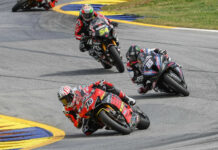HARLEY-DAVIDSON ANNOUNCES 20th RECORD YEAR Revenue, Earnings and Retail Motorcycle Sales reach all time highs Select financial data reported in the text of this press release is presented on the basis described in the Stock Option Accounting section below. Milwaukee, Wis., Harley-Davidson, Inc. (NYSE: HDI) today announced record revenue and earnings for its fourth quarter and year ended December 31, 2005. Revenue for the quarter was $1.34 billion compared with $1.22 billion in the year-ago quarter, a 9.9 percent increase. Net income for the quarter was $230.0 million compared to $209.0 million, an increase of 10.1 percent over 2004. Fourth quarter diluted earnings per share (EPS) were 84 cents, an 18.3 percent increase compared with last year’s 71 cents. Revenue for the full year was $5.34 billion, compared with $5.02 billion in 2004, a 6.5 percent increase. Net income for the year was $959.6 million, a 7.8 percent increase versus last year’s $889.8 million, while diluted EPS for the full year were $3.41, a 13.7 percent increase compared with $3.00 in 2004. “Today Harley-Davidson is celebrating an exciting milestone of twenty consecutive years of record revenue, earnings and retail motorcycle sales,” said Jim Ziemer, Chief Executive Officer. “As we reflect on our performance in 2005, we had many accomplishments. We shipped 329,000 motorcycles, which is a 3.7 percent increase over the previous year. Worldwide retail sales of Harley-Davidson® motorcycles increased 6.2 percent during 2005. Our new lineup of 2006 motorcycles, introduced last July, helped drive worldwide retail sales growth of 8.3 percent in the second half of the year. During 2005, our international motorcycle sales grew significantly and motorcycle sales to women continued to increase, demonstrating that our strategies in these areas are beginning to take hold,” said Ziemer. “We believe the prospects for retail growth remain strong and support a wholesale unit growth rate in the range of 5 to 9 percent annually and an annual EPS growth rate of 11 to 17 percent,” said Ziemer. “Our Harley-Davidson motorcycle shipment target for 2006 remains in the range of 348,000 to 352,000 units, with planned wholesale shipments of 79,000 motorcycles during the first quarter,” he said. Motorcycles and Related Products Segment Fourth Quarter Results Revenue from Harley-DavidsonÃ’ motorcycles was $1.09 billion, an increase of $95.7 million, or 9.6 percent over the same period last year. Shipments of Harley-Davidson motorcycles totaled 87,588 units, an increase of 7,001 units, or 8.7 percent over last year’s fourth quarter. Revenue from Parts and Accessories (P&A), which consists of Genuine Motor Parts and Genuine Motor Accessories, totaled $169.9 million, an increase of $12.0 million, or 7.6 percent over the year-ago quarter. Revenue from General Merchandise, which consists of MotorClothesä apparel and collectibles, totaled $60.5 million, an increase of $5.6 million, or 10.2 percent. Growth rates for P & A and General Merchandise fluctuate from quarter to quarter. However, for the long term, the Company expects the growth rate for P & A revenue to be slightly higher than Harley-Davidson’s motorcycle unit growth rate, and the General Merchandise growth rate is expected to be lower than the motorcycle unit growth rate. Gross margin for the fourth quarter of 2005 was 38.3 percent of revenue, up from 37.8 percent for the same period in 2004. Consistent with the higher gross margin, operating margin increased from 23.0 percent in 2004 to 23.4 percent in 2005. Motorcycle Retail Sales Data Worldwide retail sales of Harley-Davidson motorcycles increased 3.0 percent for the fourth quarter of 2005 compared to the same period in 2004. For the full year, worldwide retail sales increased 6.2 percent compared to 2004. U. S. retail sales of Harley-Davidson motorcycles increased 0.7 percent in the fourth quarter and 4.2 percent for the full year. For the second six months of the year, U.S. retail sales grew 7.3 percent compared to 1.9 percent for the first six months of 2005. “We are pleased with retail sales growth in the U.S. market during the second half of the year. The extensive enhancements made to existing models, along with several brand new motorcycles for the 2006 model year, are certainly generating excitement,” said Ziemer. Internationally, retail sales of Harley-Davidson motorcycles grew 13.0 percent in the fourth quarter and 15.0 percent for the full year compared with 2004. Total retail sales for 2005 increased in all of the Company’s major international markets. Data is listed in the accompanying tables. Financial Services Segment Harley-Davidson Financial Services (HDFS) reported fourth quarter operating income of $39.5 million, up 0.7 percent compared to the year-ago quarter. A fourth quarter securitization of $325 million in motorcycle retail loans resulted in a gain of $4.2 million. The 1.3 percent gain on the securitization as a percentage of loans sold is consistent with management’s prior guidance of 1.0 to 1.4 percent. Gains in the first quarter of 2006 are also expected to continue in that range. Given the relatively small percentage of HDI operating income that is generated by securitization gains, the Company is not providing guidance for periods beyond the first quarter of 2006. Income related to securitizations will continue to be reported in the Company’s annual report and SEC filings. For the long term, HDFS expects operating income to be slightly higher than the Company’s wholesale unit shipment growth rate. Harley-Davidson, Inc. Twelve Month Results For the fiscal year ended 2005, total Harley-Davidson motorcycle shipments were 329,017 units compared with 317,289 units in 2004, a 3.7 percent increase. Harley-Davidson motorcycle revenue was $4.18 billion, an increase of $255.3 million, or 6.5 percent. P&A revenue totaled $815.7 million, a $34.1 million, or a 4.4 percent increase, while General Merchandise revenue totaled $247.9 million, a $24.1 million or a 10.8 percent increase, compared with 2004. Full year operating income for HDFS was $191.6 million, an increase of $3.0 million or 1.6 percent compared to 2004. Cash Flow Twelve Month Results As of December 31, 2005, cash and marketable securities were $1.05 billion, down from $1.61 billion at December 31, 2004. During the year the Company invested $198.4 million in capital expenditures, repurchased 21.4 million shares of Company stock for $1.05 billion, paid $173.8 million in dividends and contributed $296.8 million to its retirement plans. Stock Option Accounting On January 1, 2005, the Company began recognizing expense related to its employee stock option awards before the required implementation date of the Financial Accounting Standards Board (FASB) Statement of Financial Accounting Standards (SFAS) No. 123 as revised in 2004. The Company accounted for these stock options as equity instruments. However, SFAS No. 123 (revised 2004) requires that stock options that may be settled for cash instead of stock at the election of the holder upon the occurrence of a change in control event be accounted for as a liability regardless of the probability of the change in control event occurring. The Company recently became aware of the applicability of the contingent cash settlement feature of SFAS No. 123 (revised 2004) to its employee stock compensation plans. Had the Company used the liability method to account for stock option awards during 2005, operating income would have increased by $37.8 million. Accordingly, income before accounting changes net of tax would have been $983.0 million for the year, an increase of $23.4 million compared to the Company’s reported amount of $959.6 million. In addition, on the January 1, 2005 adoption date of this accounting method, the Company would have recorded a cumulative charge to income of $120.9 million or $74.8 million net of tax for its adoption of the liability method. On January 11, 2006, FASB voted to seek public comment on a proposed FASB Staff Position (FSP) to require companies to classify employee stock options with contingent cash settlement features as equity awards provided the contingent event, such as a change in control event, is not considered probable of occurring. This classification would be consistent with the amounts reported with respect to outstanding stock options in connection with the Company’s original adoption of SFAS No. 123 (revised 2004) on January 1, 2005, and in subsequent interim periods. The Company believes that the proposed FSP is a strong indication that classification of its stock option awards as equity instruments will be appropriate upon finalization of the FSP. As a result, all financial data reported in this press release is presented on a U.S. GAAP basis adjusted for the anticipated ratification of the proposed FSP. In the event the FSP is not finalized as expected, the Company will reflect such effects on the year and the quarters in its annual report and 10-K filing for the year ended December 31, 2005. Company Background Harley-Davidson, Inc. is the parent company for the group of companies doing business as Harley-Davidson Motor Company, Buell Motorcycle Company and Harley-Davidson Financial Services. Harley-Davidson Motor Company, the only major U.S.-based motorcycle manufacturer, produces heavyweight motorcycles and offers a complete line of motorcycle parts, accessories, apparel, and general merchandise. Buell Motorcycle Company produces sport motorcycles. Harley-Davidson Financial Services provides wholesale and retail financing and insurance programs to Harley-Davidson dealers and their retail customers. Forward-Looking Statements The Company intends that certain matters discussed in this release are “forward-looking statements” intended to qualify for the safe harbor from liability established by the Private Securities Litigation Reform Act of 1995. These forward-looking statements can generally be identified as such because the context of the statement will include words such as the Company “believes,” “anticipates,” “expects,” “plans,” or “estimates” or words of similar meaning. Similarly, statements that describe future plans, objectives, outlooks, targets, guidance or goals are also forward-looking statements. Such forward-looking statements are subject to certain risks and uncertainties that could cause actual results to differ materially from those anticipated as of the date of this release. Certain of such risks and uncertainties are described below. Shareholders, potential investors, and other readers are urged to consider these factors in evaluating the forward-looking statements and cautioned not to place undue reliance on such forward-looking statements. The forward-looking statements included in this release are only made as of the date of this release, and the Company disclaims any obligation to publicly update such forward-looking statements to reflect subsequent events or circumstances. The Company’s ability to meet the targets and expectations noted depends upon, among other factors, the Company’s ability to (i) continue to realize production efficiencies at its production facilities and effectively manage operating costs including materials, labor and overhead, (ii) successfully manage production capacity and production changes, (iii) avoid unexpected supply chain issues, (iv) provide products, services and experiences that are successful in the marketplace, (v) develop and implement sales and marketing plans that retain existing customers and attract new customers in an increasingly competitive marketplace, (vi) sell all of its motorcycles and related products and services to its independent dealers and distributors, (vii) continue to develop the capacity of its distributor and dealer network, (viii) avoid unexpected changes and prepare for known requirements in legislative and regulatory environments for its products and operations, (ix) successfully adjust to fluctuations in foreign currency exchange rates, interest rates and commodity prices, (x) adjust to worldwide economic and political conditions, including changes in fuel prices and interest rates, (xi) successfully manage the credit quality and recovery rates of HDFS’s loan portfolio, (xii) retain and attract talented employees and (xiii) detect any defects in our motorcycles to minimize delays in new model launches, recall campaigns, increased warranty costs or litigation. In addition, the Company could experience delays in the operation of manufacturing facilities as a result of work stoppages, natural causes, terrorism or other factors. The Company’s ability to sell all of its motorcycles and related products and services also depends on the ability of the Company’s independent dealer network to sell them to retail customers. The Company depends on the capability of its independent dealers and distributors to develop and implement effective retail sales plans to create demand for the motorcycles and related products and services they purchase from the Company. In addition, the Company’s independent dealers and distributors may experience difficulties in selling Harley-Davidson motorcycles and related products and services as a result of weather, economic conditions or other factors. Risk factors are also disclosed in documents previously filed by the Company with the Securities and Exchange Commission.
Another Record Financial Quarter And Year For Harley-Davidson
Another Record Financial Quarter And Year For Harley-Davidson
© 2006, Roadracing World Publishing, Inc.






